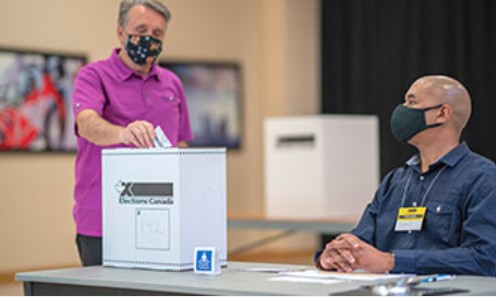Elections Canada is the independent, non-partisan agency responsible for conducting federal elections and referendums. Its mission is to ensure that Canadians can exercise their democratic rights to vote and be a candidate.
Canada is a representative democracy divided into 338 ridings. When a federal election is called, Canadians vote to elect a member of Parliament to represent them in the House of Commons, where the member will debate and pass laws on behalf of their constituents. The candidate who receives the most votes in a riding is declared the winner. This is called a “first-past-the-post” system.
Each member of Parliament has a seat in the House of Commons. Candidates can represent a political party, or can be independent, meaning they have no association with a political party.
The Canada Elections Act states that a general election shall be held on the third Monday of October every four years. However, the Act does not prevent a general election from being held on another date. By law, election day must be at least 36 days and no more than 50 days after the day when an election is called.
Elections step-by-step
1. Dissolution
The Governor General ends Parliament on the request of the Prime Minister and directs the Chief Electoral Officer to issue the writs of election. The writ is the official paperwork that launches an election in each riding.
2. Candidates
Once an election is called, each party decides who its candidate will be in each riding. A candidate can also run for election without a party, as either an “independent” or with “no affiliation.”
3. Campaigning
During the campaign period, candidates try to convince voters that they are the best choice to represent them in Parliament.
4. Voting
The most common way to vote is at the polls on election day. Electors must prove their identity and address before getting a ballot. They then go behind a voting screen to privately mark their ballot. Election workers must follow strict procedures to ensure the secrecy of the vote.
Voting hours across Canada
On the day of a general election, voting hours are staggered so that the majority of results are available at approximately the same time across the country.
Voting hours at polling stations for each time zone across Canada
Time zone Voting hours (local time)
Newfoundland Time 8:30 a.m.–8:30 p.m.
Atlantic Time 8:30 a.m.–8:30 p.m.
Eastern Time 9:30 a.m.–9:30 p.m.
Central Time* 8:30 a.m.–8:30 p.m.
Mountain Time* 7:30 a.m.–7:30 p.m.
Pacific Time 7:00 a.m.–7:00 p.m.
*In Saskatchewan, when daylight saving time is in effect for the rest of the country, voting hours are from 7:30 a.m. to 7:30 p.m. (local time).
Electoral districts spanning more than one time zone
If an electoral district spans more than one time zone, the returning officer, with the prior approval of the Chief Electoral Officer, determines one local time for voting throughout the district.
The correct voting hours will be listed on the voter information cards sent to electors living in these electoral districts. The voting hours can also be found in the online Voter Information Service under Where do I vote?
The electoral districts spanning more than one time zone are:
Labrador
Gaspésie–Les Îles-de-la-Madeleine
Kenora
Thunder Bay–Rainy River
Kootenay–Columbia
Nunavut
Registered Political Parties
- Animal Protection Party of Canada
- Bloc Québécois
- Canada’s Fourth Front
- Canadian Nationalist Party
- Christian Heritage Party of Canada
- Communist Party of Canada
- Conservative Party of Canada
- Free Party Canada
- Green Party of Canada
- Liberal Party of Canada
- Libertarian Party of Canada
- Marijuana Party
- Marxist-Leninist Party of Canada
- National Citizens Alliance of Canada
- New Democratic Party
- Parti pour l’Indépendance du Québec
- Parti Rhinocéros Party
- People’s Party of Canada
- Veterans Coalition Party of Canada
Deregistered Political Parties
- Alliance of the North (involuntary deregistration, section 415(3))
- Canadian Action Party (involuntary deregistration, section 402)
- Canada Party (involuntary deregistration, section 415(3))
- First Peoples National Party of Canada (voluntary deregistration, section 414)
- Forces et Démocratie (involuntary deregistration, section 415(3))
- National Advancement Party of Canada (voluntary deregistration, section 414)
- Natural Law Party of Canada (voluntary deregistration, section 414)
- Newfoundland and Labrador First Party (involuntary deregistration, sections 410, 415)
- Party for Accountability, Competency and Transparency (voluntary deregistration, section 414)
- People’s Political Power Party of Canada (involuntary deregistration, section 409)
- Pirate Party of Canada (involuntary deregistration, section 413(a))
- Progressive Canadian Party (involuntary deregistration, section 415(3))
- Seniors Party of Canada (involuntary deregistration, section 413(b))
- Stop Climate Change (involuntary deregistration, section 415(3))
- The Bridge Party of Canada (involuntary deregistration, section 402)
- The United Party of Canada (involuntary deregistration, section (415(3))
- United Party of Canada (voluntary deregistration, section 414)
- Work Less Party (voluntary deregistration, section 414)
- Western Block Party (involuntary deregistration, sections 410(3))
Eligible Political Parties
(see the Canada Elections Act, section 387, Eligibility for registration)
Eligible Political Parties That Have Withdrawn
- Absolutely Absurd Party (section 386)
- Québec Debout (section 386)
Political Parties That Lost Their Eligibility to Become Registered
- National Alternative Party of Canada (section 389(2))
- The Ontario Party of Canada (section 389(2))
How do I register to vote?
Register before you go to vote
Use the Online Voter Registration Service by Tuesday, September 14, 6:00 p.m.
In person at any Elections Canada office across Canada by Tuesday, September 14, 6:00 p.m.
Register when you go to vote
At your assigned polling station on election day.
At your assigned polling station on advance polling days.
At any Elections Canada office across Canada by Tuesday, September 14, 6:00 p.m.
(Editor: Carol)


